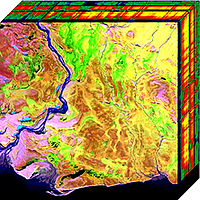
Photo from wikipedia
Focal plane array (FPA) detectors have escalated Fourier transform infrared (FTIR) microspectroscopy to a potent hyperspectral imaging method. Yet, despite the instrumental multiplex/multichannel advantages, the fidelity of the hyperspectral images… Click to show full abstract
Focal plane array (FPA) detectors have escalated Fourier transform infrared (FTIR) microspectroscopy to a potent hyperspectral imaging method. Yet, despite the instrumental multiplex/multichannel advantages, the fidelity of the hyperspectral images relies on the throughput as the total flux of the source is divided among each FPA pixel. Additionally, maintaining the spectral resolution requires a certain level of collimation of the beam which adversely affect the flux of high étendue source. To this end, we propose an implementation of two deformable mirror (DM) sensorless adaptive optics system for infrared (IR) source coupling. The deflection shape of each DM membrane is optimized individually to deal with the beam intensity and the rays' direction in a separate manner, while preserving the spectral quality across the entire mid-IR range. This paper contemplates the choice of metrics in sequential optimization in conjunction with two variations of stochastic parallel gradient descent optimization algorithm. We discuss this approach with respect to a state-of-the-art FTIR microscope.
Journal Title: Optics letters
Year Published: 2022
Link to full text (if available)
Share on Social Media: Sign Up to like & get
recommendations!